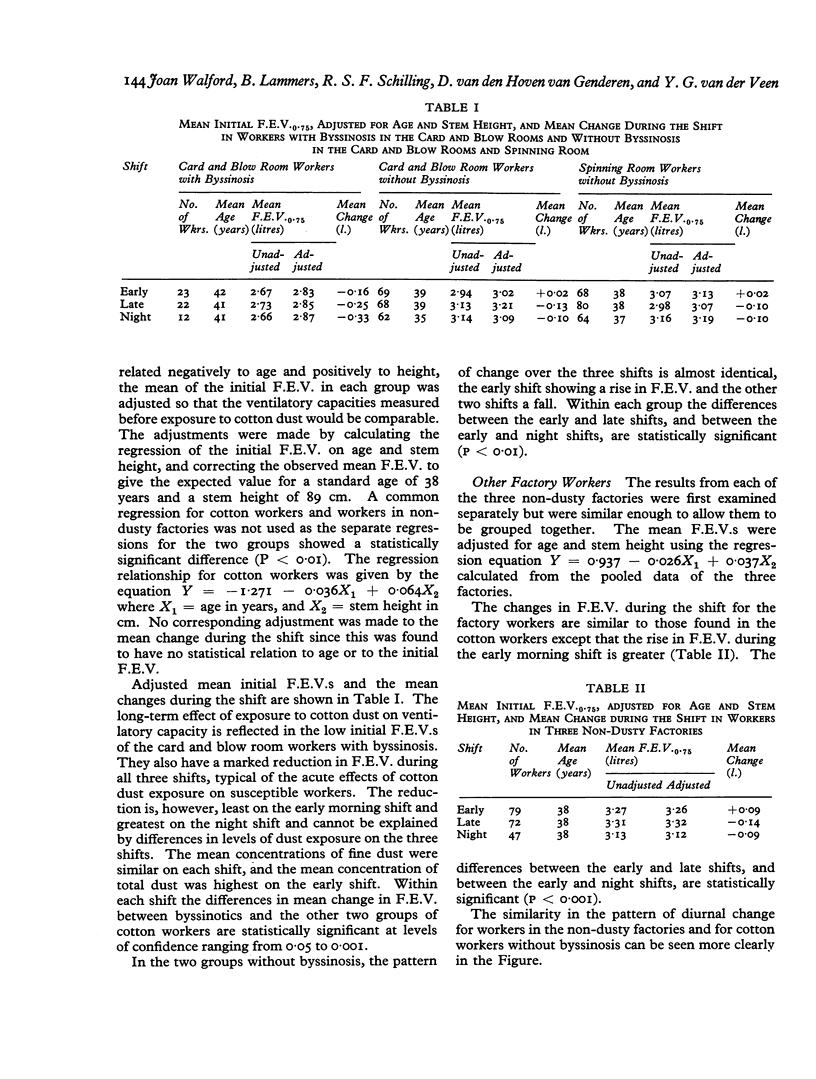Abstract
The change in F.E.V.0·75 during a working shift was studied in a random sample of 473 men employed in three cotton mills in The Netherlands working a three-shift system. Results were also obtained for 198 men, not exposed to industrial dust, who were working in a biscuit factory and two textile factories in the same area. The men were seen only during the shift on which they were working at the time of the study.
Men with byssinosis gave a typical picture of the effects of cotton dust on susceptible workers: a generally low F.E.V. with a marked reduction during the shift; –0·16 l. on the early morning shift, and –0·25 l. and –0·33 l. respectively on the afternoon and night shifts.
Men without byssinosis in the card and blow rooms showed mean changes in F.E.V. during the shift similar to those of men working in the spinning room: a slight rise in the early morning shift of +0·02 l. followed by a fall in both afternoon and night shifts in the region of –0·10 litres. This pattern of change was also found among the workers in the non-dusty factories. The rise in the early shift cannot be explained by the clearing of mucus from the air passages; cotton workers without respiratory symptoms and men in the non-dusty factories who did not produce sputum still showed an increase in F.E.V. during the early shift, though less marked than that of men with respiratory symptoms or who produced phlegm.
The evidence suggests that a diurnal variation in lung function exists and should be taken into consideration both in epidemiological studies and when ventilatory capacity tests are used in periodic medical examinations.
Full text
PDF






Selected References
These references are in PubMed. This may not be the complete list of references from this article.
- BOUHUYS A., HARTOGENSIS F., KORFAGE H. J. BYSSINOSIS PREVALENCE AND FLAX PROCESSING. Br J Ind Med. 1963 Oct;20:320–323. doi: 10.1136/oem.20.4.320. [DOI] [PMC free article] [PubMed] [Google Scholar]
- BOUHUYS A., van DUYN, van LENNEP H. Byssinosis in flax workers. Arch Environ Health. 1961 Nov;3:499–509. doi: 10.1080/00039896.1961.10663061. [DOI] [PubMed] [Google Scholar]
- LAMMERS B., SCHILLING R. S., WALFORD J., MEADOWS S., ROACH S. A., VAN DEN HOVEN D., VAN DEN VEEN Y. G., WOOD C. H. A STUDY OF BYSSINOSIS, CHRONIC RESPIRATORY SYMPTOMS, AND VENTILATORY CAPACITY IN ENGLISH AND DUTCH COTTON WORKERS, WITH SPECIAL REFERENCE TO ATMOSPHERIC POLLUTION. Br J Ind Med. 1964 Apr;21:124–134. doi: 10.1136/oem.21.2.124. [DOI] [PMC free article] [PubMed] [Google Scholar]
- LEWINSOHN H. C., CAPEL L. H., SMART J. Changes in forced expiratory volumes throughout the day. Br Med J. 1960 Feb 13;1(5171):462–464. doi: 10.1136/bmj.1.5171.462. [DOI] [PMC free article] [PubMed] [Google Scholar]
- RICHARDSON D. W., HONOUR A. J., FENTON G. W., STOTT F. H., PICKERING G. W. VARIATION IN ARTERIAL PRESSURE THROUGHOUT THE DAY AND NIGHT. Clin Sci. 1964 Jun;26:445–460. [PubMed] [Google Scholar]


